May 2023
- PREVIOUS
- NEXT
- English
- 日本語
Sea Bream—A Special Fish for the Japanese People
-

Dr. Yoshida Munehiro, special contract professor and professor emeritus, Kansai University -

A vividly colored sea bream float makes an appearance at the Karatsu Kunchi Festival.
-
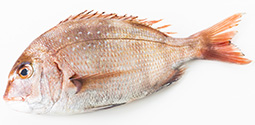
Madai, the most well-known of the tai fish -
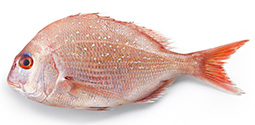
Chidai, also called kodai ("little tai") for its charming appearance -
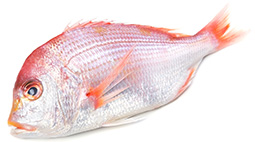
Kidai, also known as renko-dai in certain regions of Japan -
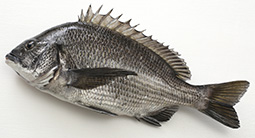
Kurodai, with darker scales than other tai species -
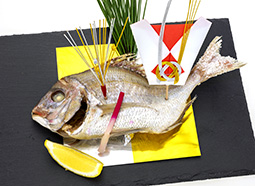
Grilled sea bream served whole with head and tail, called iwaidai, served at celebratory occasions -
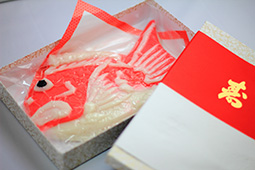
Toyama Prefecture's sea bream-shaped kamaboko, given as a gift on celebratory occasions -
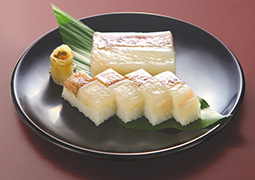
Kodai suzumezushi, a dish developed to preserve fish. The name comes from the fact that the fish belly filled with sushi rice resembles a sparrow.
Photo: Souhonke kodaisuzumezushi sushiman -
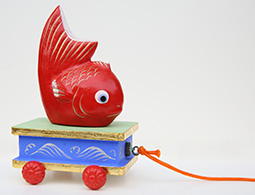
A popular souvenir as a good-luck charm, this familiar local toy still retains the name tai-guruma.

In Japan, sea bream (tai) is a favorite fish thought to bring good luck and one that is essential to traditional events and special occasions. Why is this fish so special? Dr. Yoshida Munehiro, special contract professor and professor emeritus at Kansai University and an authority on nutrition and an expert on Japanese food, explains.
What types of sea bream are found in Japan?
The biological classification for this family of fish is called Tai (Sparidae). Four species live in the seas around Japan: madai (red sea bream), chidai (crimson sea bream), kidai (yellowback sea bream), and kurodai (black porgie). Other than the kurodai, all of the other three have red bodies, making it difficult for the ordinary person to distinguish between them. The madai grows to be about a meter long, the chidai and the kidai grow to be about 30 centimeters. Most of the tai that is typically available to consumers is madai, though chidai and kidai are also sometimes served at festive banquets because 30 centimeters is a good length for grilled fish served whole with head and tail.
The Japanese names for other fish outside of the Tai family can also include the "tai" element such as amadai (tilefish), ishidai (parrot fish), and kinmedai (splendid alfonsino). These are referred to ayakari-dai, and their names are thought to be based on the popularity (ayakari in Japanese) of tai.


What are the characteristics of sea bream?
All species in the Tai family are found close to land and do not migrate like bonito and other fish. Because they do not have to swim long distances, they have less myoglobin, the red-colored protein that carries oxygen, in their muscles, so their flesh is white. Tai feed on small fish and crustaceans. Having relatively sharp teeth, kurodai and other species can even eat shellfish. The red hue on the body of the madai and other types of tai comes from the accumulation of red pigment from eating crustaceans.
Much more madai is raised on fish farms than caught in the wild. For this reason, madai is readily available on the market.
When did Japanese people start eating sea bream?
Madai and kurodai bones have been excavated from ruins dating back to the Jomon period (about 10,000 years ago), so we think that they have been eaten here for a very long time. The bones at the Sannai-Maruyama Site* in Aomori Prefecture were excavated intact and indicated that the fish was cut with a sharp blade using the technique we today call sanmai oroshi.** The name tai appears in the anthology of Japanese poetry, Manyoshu ("Collection of Ten Thousand Leaves"),*** which was compiled some 1,300 years ago. There is also a description of tai in the Kojiki ("Records of Ancient Matters")**** from the same period, all of which suggests that Japanese people have been familiar with sea bream since ancient times.


Could you explain the reasons and history of how sea bream came to be such an ingrained symbol of good luck in Japanese culture?
The belief that sea bream is an auspicious fish seems to date back to antiquity, as far back as some 1,300 years ago. The Engi-Shiki, a set of ancient Japanese governmental regulations, records the type of offerings made at shrines then. According to these records, sea bream and carp were presented at the shrine as a ritual offering to the gods at that time. In ancient times, kurodai was easier to catch than madai, so I imagine catching madai, which is much larger than kurodai, would have been extremely gratifying. In Japan, the color red has been believed since ancient times to ward off evil. This is another reason, I think, that madai, a large red fish with few small bones, came to be valued as a symbol of good luck.
Moreover, as the saying "It's still a sea bream even if it's rotted" suggests, sea bream is a fish with low levels of protein-degrading enzymes. This means it is less susceptible to spoiling than other fish, making it suitable as an offering at Shinto rituals and other special occasions. Even today, grilled sea bream is served whole with head and tail at traditional events such as New Year's, wedding receptions, and okuizome ceremony (see "Whole Sea Bream: An Essential Part of Japan's Traditional Okuizome Ritual") This is due in part to the fact that it is suitable for festive occasions since it stays fresh longer than other fish. In fact, it stays fresh so long that it has been customary to take sea bream served at a reception home as a wedding favor without eating it during the banquet.

Sea bream also has an extremely nice shape and a beautiful appearance, and this in itself makes a nice motif at celebrations, doesn't it? In some mountainous areas where fishing for sea bream is not possible, people weave rice straw or other material into a sea bream shape to symbolize good luck. A more modern example is the sea bream-shaped kamaboko***** in Toyama. I've also seen sugar confections in the shape of sea bream given out as wedding favors.

Sea bream was a fish so special that was presented as an offering in Shinto rituals. When do you think the common people in Japan began to eat it? And is sea bream a favorite in regular households in Japan today?
It seems that it was not until about 300 years ago, when the political authority at that time, the Edo Shogunate, established distribution routes across the whole of Japan, that the general public had a taste of sea bream. To begin with, sea bream is caught mostly in western Japan along the coast of the Seto Inland Sea, for example, and even today western Japan dominates eastern Japan in the consumption of sea bream. This is partly due to tuna's rising popularity in eastern Japan since around the 1960s, with its consumption there greatly increasing ever since. Today, sea bream is consumed mostly in western Japan, which includes Kyushu, Kyoto, and Osaka, where it is cooked in a variety of different ways.
Can you tell us about sea bream-related culture, such as dishes or festivals and customs?
Sea bream has white flesh without a strong fishy taste, so it works well in many different types of dishes. Sashimi and grilled are the most well-known examples, but there is also tai-meshi and tai-somen (whole sea bream served on noodles). The traditional tai-meshi is usually made with grilled sea bream and rice cooked in konbu dashi stock. In Uwajima in Ehime Prefecture, though, tai-meshi refers to sea bream sashimi marinated in beaten egg, seasoned with sauce, and served on rice.
Young madai, chidai, and kidai about 10 centimeters long are caught in large numbers off the coast. In many places in Japan, these are eaten dressed with vinegar. Kodai no sasa-zuke (pickled small sea bream flavored with bamboo) from Obama City in Fukui Prefecture is made with young kidai, while the fish used for kasugo, an Edomae-style sushi dish, is mainly young chidai. In Osaka, young madai is called chariko and is served as kodai suzumezushi ("small sea bream sparrow sushi") after being dressed in vinegar. Another dish that uses chariko is the suzumezushi from Wakayama Prefecture.

Photo: Souhonke kodaisuzumezushi sushiman
In regions where people eat a lot of sea bream, the fish is something of a star player at festivals. During the Karatsu Kunchi Festival in Saga Prefecture, an array of floats****** are pulled through the street to purify the way before the mikoshi (sacred religious palanquin) proceed. Among these is the tai-guruma, a float featuring a sea bream motif. Tai-guruma like this were likely found in many places in the past, like Shimane and Niigata Prefectures. In Minamichita-cho in Aichi Prefecture, there is also a festival featuring only large sea bream floats (see "Massive Sea Bream Floats on Parade: The Tai Matsuri Festival in Toyohama Harbor"). Interestingly, in Niigata, hiki-chochin paper lanterns in the shape of sea bream are wheeled through the streets during O-bon, an annual event for commemorating one's ancestors.

Sea bream has been considered a special fish in Japan since ancient times. Although the Japanese character for tai means "flat fish," a different theory holds that the word originates from the Japanese compound tai'i, meaning "the king of fish," while the word koi for carp comes from the compound ko'i, meaning "king of river fish." Sea bream has been a highly prized fish of a distinct class, eaten on such important occasions as the Hochoshiki Ceremonial Carving held in front of the gods******* (a Shinto ritual to pray for good harvests and peace), as part of Imperial palace cuisine, and at celebrations including weddings. It is truly a Japanese fish of world-class status.

* The most well-known Jomon period settlement in Japan, it is a registered UNESCO World Heritage Site.
** A knife is used to cut the fish along either side of the center bones, creating three sections—two fillets and the spine.
*** Japan's oldest extant collection of classic Japanese waka poems, dating from the late 8th century and containing approximately 4,500 waka
**** Japan's oldest history book, recorded in 712
***** A food made from fish paste that is seasoned with salt and other seasonings, then shaped and steamed or baked
****** Decorative carts brought out for festivals
******* See "Carrying on 1,200 Years of Japanese Culinary Tradition" in the June 2022 issue of Highlighting Japan
Japanese version https://www.gov-online.go.jp/eng/publicity/book/hlj/html/202206/202206_02_jp.html
English version https://www.gov-online.go.jp/eng/publicity/book/hlj/html/202206/202206_02_en.html
- PREVIOUS
- NEXT

